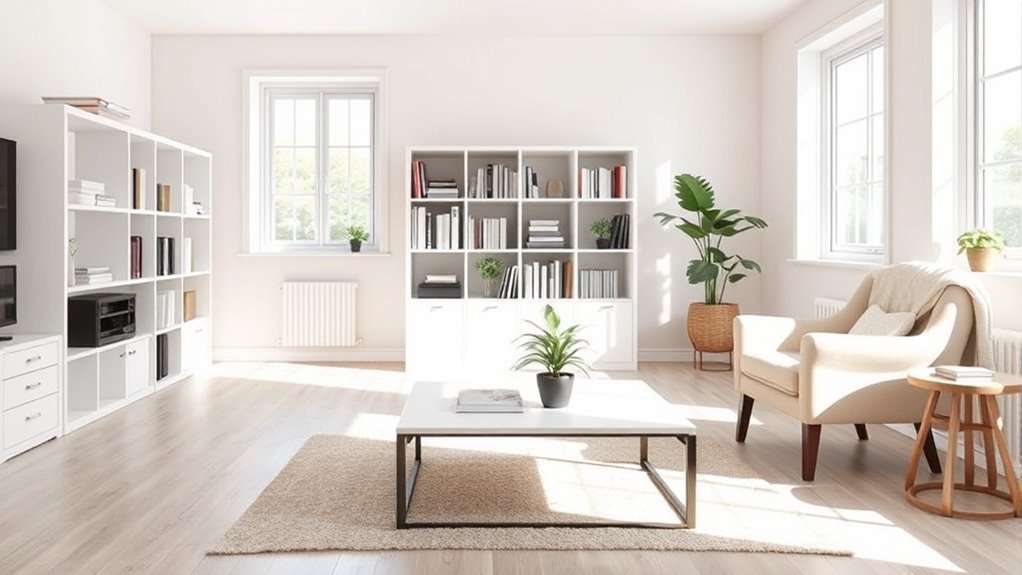Stop procrastinating and trying to overhaul everything at once. Instead, set clear, manageable goals and focus on small areas or sections. Avoid creating “maybe” piles or keeping sentimental items just because they feel difficult to part with. Use storage solutions that fit your space and prioritize items you use regularly. Stay mindful of distractions and maintain your organization with regular upkeep. Keep these tips in mind, and you’ll discover more strategies for a clutter-free space.
Key Takeaways
- Stop rushing through decluttering; instead, take your time and focus on thorough, manageable steps.
- Avoid creating “maybe” piles; instead, decide on each item’s value based on recent use and necessity.
- Don’t overhaulate everything at once; instead, tackle small sections gradually for sustainable progress.
- Stop blaming space limitations; instead, reevaluate storage solutions and optimize existing space creatively.
- Avoid clutter accumulation by maintaining regular upkeep and focusing on items used frequently for long-term organization.
Stop Procrastinating and Set Clear Goals

Procrastination often keeps you from making progress, but the first step to decluttering is to recognize that putting it off only makes the mess worse. To break free, focus on improving your time management and setting clear goals. Decide what you want to achieve—whether it’s clearing a specific area or completing the task in a set time. Break the process into manageable steps, like sorting items into keep, donate, or discard. Setting specific goals keeps you motivated and gives your efforts direction. Avoid vague intentions like “clean later”—be precise. By prioritizing and planning your decluttering, you’ll find it easier to start, stay on track, and see real progress without feeling overwhelmed. Incorporating goal setting principles can further enhance your ability to stay committed and organized throughout the process.
Avoid Overhauling Everything at Once
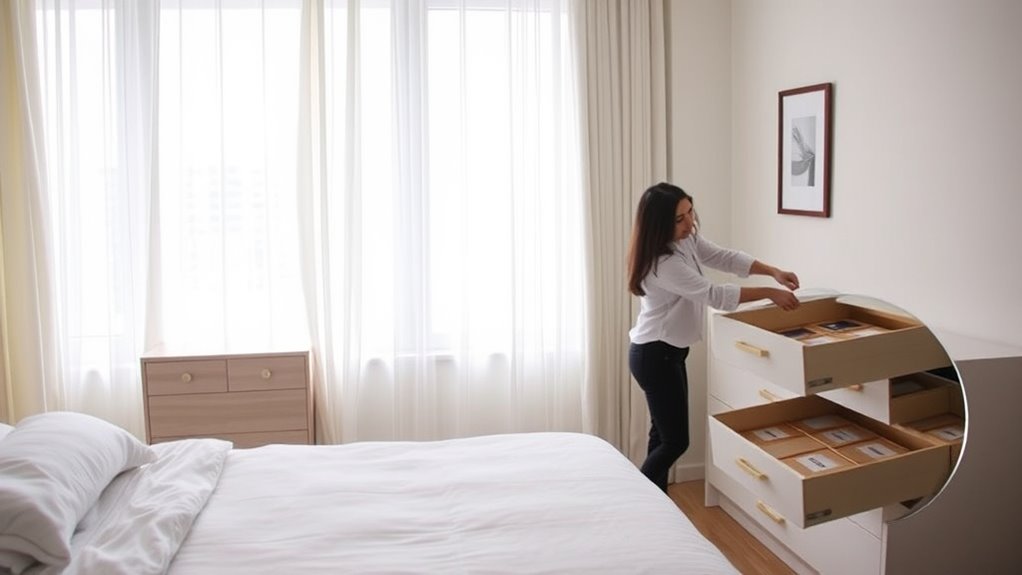
Trying to overhaul your entire room in one go can quickly become overwhelming and lead to burnout. Instead of attempting a complete transformation all at once, focus on small, manageable changes. For example, rearranging furniture can refresh the space without a major overhaul. Move pieces around to create better flow or designated zones. When decorating walls, pick a single area or a few frames instead of trying to redo everything. This approach keeps you motivated and allows you to enjoy the process. By breaking down the task, you prevent frustration and maintain momentum. Remember, decluttering is about progress, not perfection. Tackle one section at a time, and you’ll gradually see a cleaner, more organized room without feeling overwhelmed. Practical tips can help you stay on track and make the process more enjoyable.
Don’t Keep Items Just Because They Were Sentimental

Have you ever kept an item solely because it held sentimental value, even if it no longer serves a purpose? Sentimental items can create emotional attachment that’s hard to ignore. But holding onto everything out of nostalgia can clutter your space and make it harder to find what you truly need. Instead, evaluate whether those items truly bring you joy or serve a meaningful purpose today. Take photos of keepsakes you want to remember without keeping the physical object. Consider donating or repurposing items that no longer fit your life. Remember, emotional attachment doesn’t mean you have to hold onto everything; it’s about preserving memories, not clutter. Letting go of unnecessary sentimental items creates a cleaner, more intentional space for what matters most. Engaging in aquatic exercise can also help you relax and gain perspective, making it easier to decide what to keep.
Refrain From Creating a Pile of “Maybe” Items
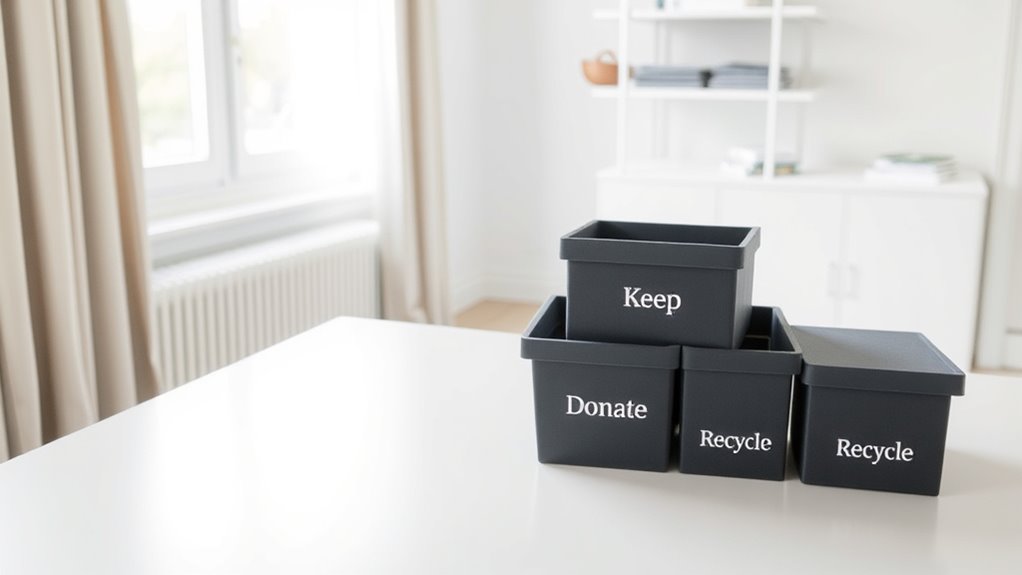
Stop holding onto items just because you’re unsure if you’ll need them later. Focus on identifying what you genuinely use and need daily. Limiting your “maybe” pile makes it easier to keep your space organized and clutter-free. Consider applying strategic collaboration principles from hackathons to brainstorm what items truly add value to your space.
Identify Truly Needed Items
To effectively declutter, you need to honestly evaluate which items you truly use or need regularly. Avoid the temptation to create a pile of “maybe” items; instead, focus on what serves a purpose in your daily life. Gather similar items and decide if they’re essential. Use storage bins to contain items, making it easier to see what you have. Label systems help keep things organized and ensure you can quickly identify needed items later. Ask yourself if you’ve used the item in the past year or if it adds value to your space. If the answer is no, it’s time to let it go. Clear distinctions between needed and unnecessary items make your decluttering process more effective and prevent future clutter build-up. Incorporating special event planning principles can also help you set aside items that might be useful for themed breakfasts or community gatherings, ensuring your space remains functional and inviting.
Limit “Maybe” Possibilities
When evaluating items during decluttering, it’s easy to fall into the trap of setting aside “maybe” piles—things you’re unsure about but might need someday. This creates mental clutter and hampers your minimalist mindset. Instead of hoarding uncertain items, challenge yourself to make definitive decisions. Ask, “Have I used this in the past year?” If not, let it go. Limiting “maybe” possibilities keeps your space streamlined and your mind clear. Remember, clutter isn’t just physical; it drains mental energy too. By refraining from creating piles of “maybe” items, you avoid unnecessary indecision and space-consuming hesitation. Your goal is a room that feels open and intentional, reflecting a mindset focused on what truly matters and what you genuinely need. Incorporating decision-making strategies can further support maintaining an organized and clutter-free environment.
Stop Ignoring the Storage Solutions That Suit Your Space

Have you been overlooking storage solutions that actually fit your space? Many overlook effective options that enhance space utilization and storage innovation. Instead of bulky furniture or cluttered shelves, consider customized solutions like wall-mounted units or multi-purpose furniture. These can transform your room without sacrificing space. Use the table below to explore options: Copyright and Affiliate Disclosure
Don’t Skip Sorting Items Into Categories
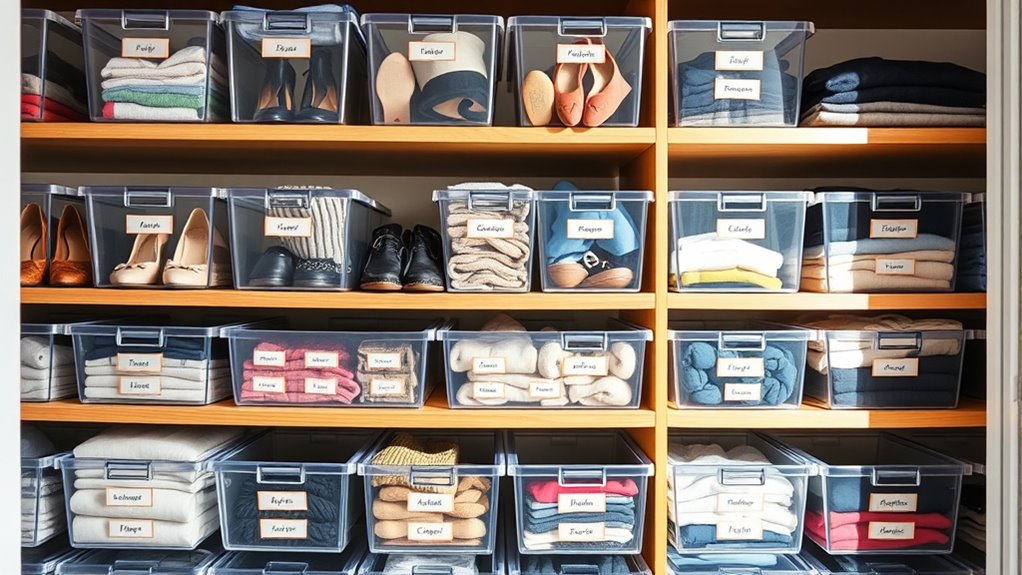
When sorting your items, make sure to organize them by type rather than mixing everything together. This keeps things clearer and easier to find later. Also, prioritize putting away items you use most often to save time and reduce frustration. Additionally, understanding asset division impacts can motivate you to organize your belongings efficiently during the decluttering process.
Organize by Type
Why is it so effective to organize a room by type rather than by location? When you categorize items by their type, you simplify access and create clear storage solutions. This method makes it easier to find what you need quickly and ensures everything has an assigned place. Use categorization techniques to group similar items together—like all books, electronics, or craft supplies—in designated containers or shelves. Organizing by type reduces clutter and prevents items from being scattered around different areas. It also streamlines the decluttering process, helping you decide what to keep or discard. Additionally, farmhouse kitchen textiles and accessories can be organized by type to maintain a charming and functional aesthetic. By focusing on item categories, you establish a logical system that promotes lasting order and efficiency, making your space more functional and less chaotic.
Avoid Mixing Items
Skipping the step of sorting items into categories can quickly undo your organizational efforts. When you mix unrelated items, your space loses harmony and balance, making it chaotic rather than calming. Without clear categories, the aesthetic appeal diminishes, and clutter feels overwhelming. To restore order, group similar items together, creating visual harmony. Use this table to visualize the importance of categorization:
| Category | Items Included |
|---|---|
| Books & Magazines | All reading materials |
| Electronics | Cables, chargers, gadgets |
| Clothing | Shirts, pants, accessories |
| Toys & Games | Kids’ toys, board games |
| Miscellaneous | Random items, knick-knacks |
Sorting into categories helps you achieve a balanced, inviting space that feels both organized and beautiful. Focusing on organized storage techniques can further enhance your farmhouse bedroom’s cozy charm.
Prioritize Frequent Use
Prioritizing items based on how often you use them guarantees your space remains functional and efficient. Focus on placing frequently used items in easily accessible storage solutions, so you save time and avoid unnecessary clutter triggers. When sorting, keep everyday essentials within reach, while infrequently used items can go in less accessible areas. This approach prevents clutter from building up and helps you maintain a streamlined space. Remember, clutter triggers often stem from tossing items randomly or storing things without thought. By categorizing your belongings and emphasizing items you use regularly, you create a more organized environment. Additionally, understanding the importance of contrast ratio in projectors helps ensure your entertainment space is both practical and visually appealing. This method not only simplifies your decluttering process but also encourages consistent habits that keep your room tidy long-term.
Avoid Distractions That Interrupt Your Progress
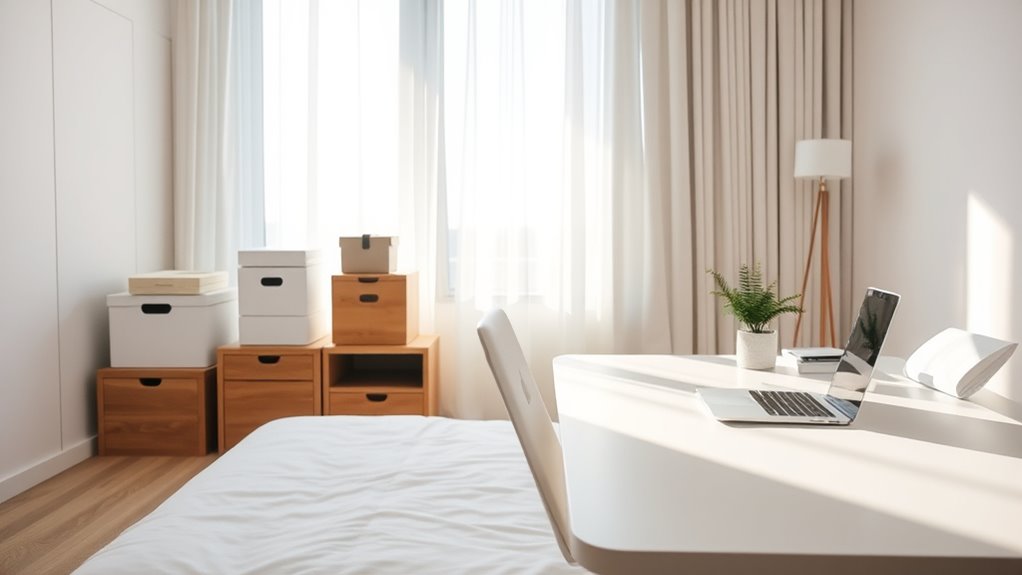
Distractions can quickly derail your efforts to declutter a room, making it harder to stay focused and motivated. Digital distractions like notifications, social media, or emails can pull your attention away, wasting valuable time. It’s tempting to check your phone, but multitasking pitfalls often lead to longer, less productive sessions. To stay on track, turn off notifications and set specific intervals for breaks. Keep your phone out of reach or in another room if necessary. Avoid shifting between tasks; focus on one area at a time. This minimizes interruptions and helps you maintain momentum. By creating a distraction-free environment, you’ll declutter more efficiently and feel more accomplished as you progress. Staying focused is key to transforming your space with less frustration. Additionally, implementing focused work techniques can further enhance your productivity during decluttering sessions.
Stop Making Excuses for Clutter Accumulation
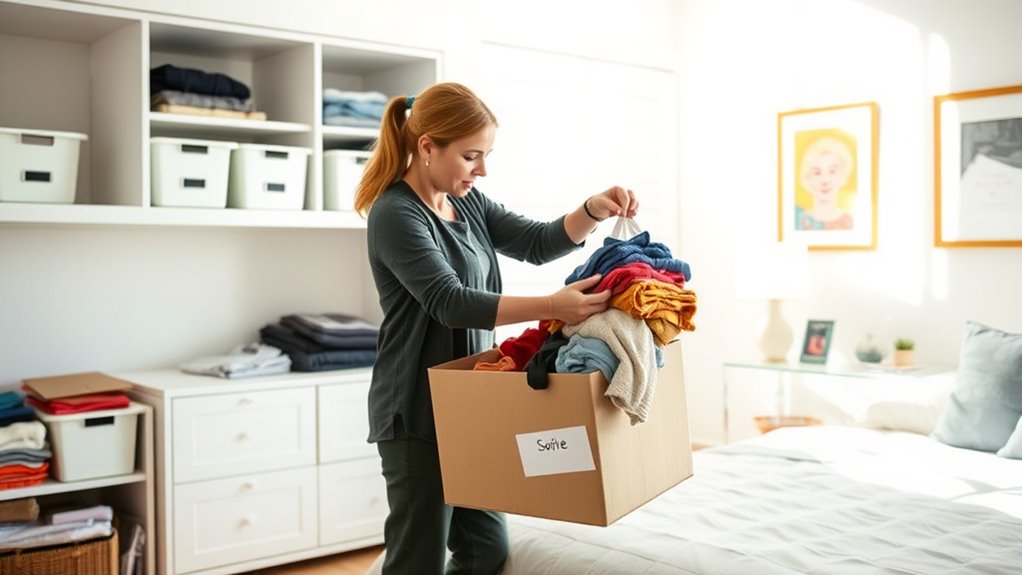
You might tell yourself there’s not enough space, but often, clutter builds up because you ignore regular maintenance. Delaying decisions about what to keep or toss only makes the mess worse. Stop making excuses—taking responsibility is the first step to a cleaner, more organized room. Incorporating regular assessment and rotation of belongings can help prevent clutter from accumulating over time.
Blaming Limited Space
Many people justify clutter by blaming limited space, but this excuse often masks deeper habits. Space constraints and storage limitations aren’t the real issues—they’re just surface-level reasons. If you constantly feel overwhelmed by clutter, it’s time to reevaluate how you’re using your space. Instead of blaming the size of your room, focus on optimizing what you already have. Get creative with storage solutions, like vertical shelving or multi-purpose furniture, to make better use of available space. Remember, clutter isn’t solely about room size; it’s about your habits and choices. By shifting your mindset from “not enough space” to “better organization,” you’ll take control of your environment and reduce clutter more effectively. Exploring best beaches can also inspire you to create a more relaxing and organized environment at home.
Ignoring Maintenance Routines
Even with smart storage solutions, neglecting regular maintenance routines can cause clutter to creep back in. Storage optimization isn’t a one-time fix; it requires consistent effort through routine scheduling. If you ignore daily or weekly upkeep, clutter quickly accumulates, undoing your organization efforts. Make it a habit to put items back in their designated places immediately after use, and schedule regular decluttering sessions. These routines keep your space manageable and prevent clutter from building up unnoticed. Without routine maintenance, even the best storage systems fail. Stay proactive by setting reminders or calendar alerts to review and reset your organization system. Consistent upkeep is key to maintaining a clutter-free environment and ensuring that your decluttering efforts stick long-term.
Delaying Disposal Decisions
Delaying disposal decisions allows clutter to accumulate effortlessly, often because it’s easier to justify keeping items than to face the effort of sorting and discarding. But postponing these choices only prolongs the chaos. To make real progress, you need to commit to timely disposal and decisive action. Set specific deadlines for sorting items and stick to them. When you decide immediately whether to keep, donate, or toss, you prevent clutter from piling up. Remember, quick decisions save time and mental space. The longer you delay, the harder it becomes to clear space. Taking proactive steps can significantly boost your motivation and make the decluttering process smoother. Trust your judgment, act promptly, and turn clutter into organized space. Doing so accelerates your decluttering progress and creates a more functional, peaceful room.
Don’t Forget to Maintain Your Organized Space Regularly
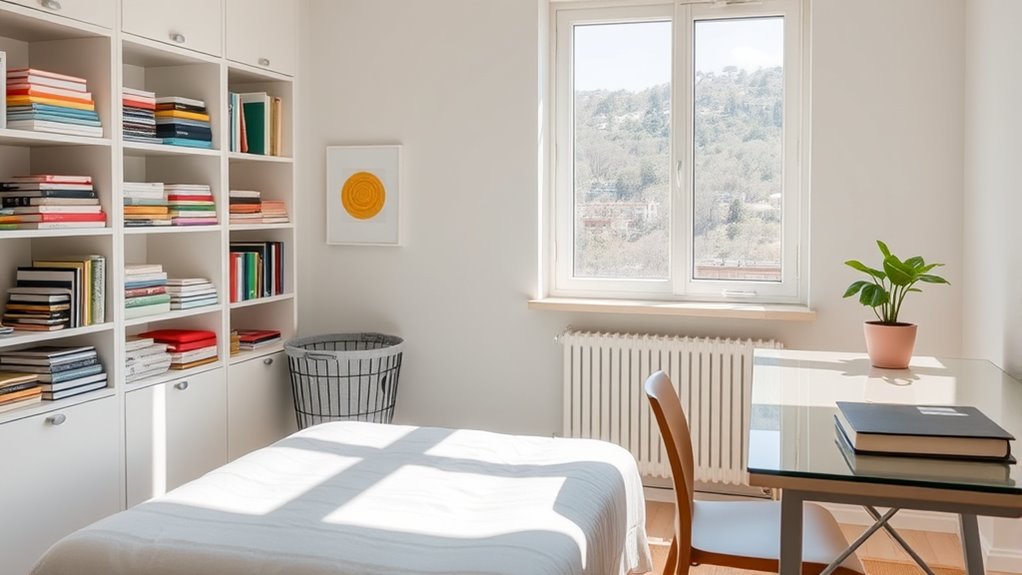
Maintaining your organized space requires consistent effort to prevent clutter from creeping back in. Regular routine checks help you stay on top of clutter and keep your storage solutions effective. Schedule weekly or bi-weekly reviews of your space to assess what’s working and what needs adjustment. Use versatile storage solutions to keep items contained and easily accessible, making tidying quick and simple. Consider the following strategies:
| Action | Benefit |
|---|---|
| Schedule routine checks | Prevents clutter buildup |
| Adjust storage solutions | Ensures accessibility and efficiency |
| Incorporate storage solutions | Optimizes space utilization and organization |
Avoid Rushing the Process and Expecting Instant Results

While it’s tempting to see quick results after decluttering, rushing through the process can lead to frustration and incomplete organization. Seeking instant gratification often encourages rushed decisions that might not be the best in the long run. Take your time, and focus on one area at a time, rather than trying to declutter everything all at once. Patience helps you make thoughtful choices about what to keep, donate, or toss. Remember, a well-organized space isn’t built overnight. Rushing can cause you to overlook items you genuinely need or want, leading to future clutter. Instead, set realistic expectations and allow yourself the time to do thorough, mindful decluttering. Incorporating layered textiles and natural decor elements can also create a more inviting and harmonious space during the process. The results will be more satisfying and sustainable if you avoid the trap of instant gratification.
Frequently Asked Questions
How Often Should I Revisit My Decluttering Plan?
You should revisit your decluttering plan every three to six months to stay organized. Regular decluttering allows you to assess your storage solutions and identify items you no longer need. By maintaining a consistent decluttering frequency, you prevent clutter buildup and keep your space functional. Set reminders and adjust your plan as needed, ensuring your storage solutions remain effective and your environment stays tidy and welcoming.
What Tools Are Best for Effective Organization?
A place for everything, and everything in its place. To organize effectively, invest in versatile storage solutions like stackable bins, drawer organizers, and shelves. Use label systems to keep things clear and easy to find. These tools streamline your space and save time, making decluttering a breeze. With the right storage solutions and labels, you’ll maintain order effortlessly and enjoy a tidy room that stays organized long-term.
How Do I Handle Sentimental Items I Want to Keep?
When handling sentimental items you want to keep, acknowledge your sentimental attachment and prioritize keepsake preservation. Choose a few meaningful pieces instead of keeping everything, and consider photographing or digitizing others to reduce clutter. Store your keepsakes in a dedicated box or display them thoughtfully. This way, you honor your emotional connection while maintaining an organized space, making your room both functional and filled with meaningful memories.
Can Decluttering Improve Mental Health?
Imagine your mind as a garden—decluttering acts like tending to weeds, clearing emotional clutter. When you engage in mindful sorting, you release emotional attachments that weigh you down, fostering clarity and peace. This process can markedly improve mental health by reducing stress and creating space for positive growth. By consciously choosing what to keep or let go, you nurture your well-being and cultivate a balanced, healthier mindset.
What Are Quick Tips for Maintaining a Clutter-Free Space?
To keep your space clutter-free, try quick organization hacks like using labeled storage solutions for frequently used items. Incorporate small, accessible bins or baskets to contain messes before they spread. Regularly dedicate five-minute sessions to tidying up, and always put things back where they belong. These simple organization hacks will save you time and keep your space neat, making maintenance effortless and stress-free.
Conclusion
Now that you know what to avoid, are you ready to approach decluttering with patience and purpose? Remember, rushing or holding onto unnecessary items only stalls your progress. By setting clear goals and staying consistent, you’ll create a space that truly works for you. So, why settle for chaos when a simple, mindful process can turn your clutter into calm? Take action today and enjoy the organized, peaceful room you deserve.
